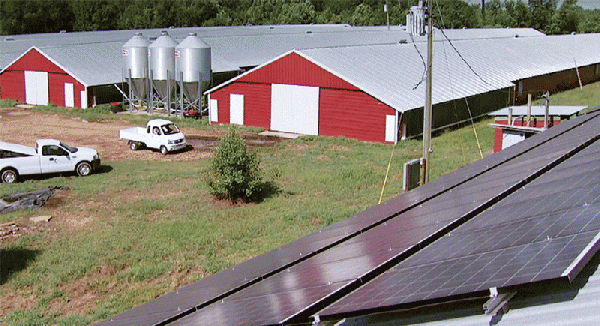
Grants, loans available for ag renewable energy systems
“Based on these grants and offers available, it’s possible to save about 55 percent of the cost to implement a renewable energy system. This may be the last chance to take advantage of such a great grant offer from the USDA."

Agricultural operations may be eligible for USDA grants of up to $20,000 to convert systems to renewable energy.
According to the USDA Rural Development Agency’s fact sheet, the grants are available to small businesses in rural areas and to agricultural producers who obtain at least 50 percent of gross income from ag operations.
Funds may be used for the purchase, installation, and construction of renewable energy systems, including biomass (including biodiesel and ethanol, anaerobic digesters, and solid fuels), small and large wind generation, and small and large solar generation.

Poultry houses, because of their usual east/west orientation, are well-suited to solar installations.
Poultry houses, because of their usual east/west orientation, are well-suited to solar installations.Funds may also be used for the purchase, installation, and construction of energy efficiency improvements, such as electric, solar, or gravity pumps for sprinkler pivots, switching from a diesel to an electric irrigation motor, and other options.
Funding available includes loan guarantees on loans up to 75 percent of total eligible project costs; grants for up to 25 percent of total eligible project costs; and combined grant and loan guarantee funding up to 75 percent of total eligible project costs.
IT’S FREE! Stay informed on what’s happening in Mid-South agriculture: Subscribe to Delta Farm Press Daily.
“Based on these grants and offers available, it’s possible to save about 55 percent of the cost to implement a renewable energy system,” says Will Hegman, founder and president of Mississippi Solar, whose company has done solar systems for poultry houses and other ag applications, and is offering assistance in completing grant applications for solar installations.
The deadline for submitting an application is October 15, he says, and the process takes about two weeks. “This may be the last chance to take advantage of such a great grant offer from the USDA,” he says.
The USDA fact sheet notes that terms for the loan guarantee are $5,000 minimum loan amount; $25 million maximum loan amount; and up to 85 percent loan guarantee.
Rates and terms are negotiated with the lender and subject to USDA approval. The maximum term for real estate is 30 years. For machinery and equipment, the maximum term is 15 years, or useful life. For capital loans, the maximum term is 7 years. For combined real estate and equipment loans, the maximum term is 30 years.
Terms for Renewable Energy System Grants are $2,500 minimum, $500,000 maximum; for Energy Efficiency Grants, $1,500 minimum and $250,000 maximum.
Other requirements are that applicants must provide at least 75 percent of the project cost if applying for a grant only. If applying for a loan or loan/grant combination, the applicant must provide at least 25 percent of the project cost. Energy efficiency projects require an energy audit or assessment.
The USDA Rural Development Agency says the program helps to increase American energy independence by increasing the private sector supply of renewable energy and decreasing the demand for energy through energy efficiency improvements. Over time, the agency says, these investments can also help to lower the cost of energy for small businesses and agricultural producers.
Additional information is available at state USDA Rural Development offices. Mississippi Solar can be contacted at [email protected]
About the Author(s)
You May Also Like



